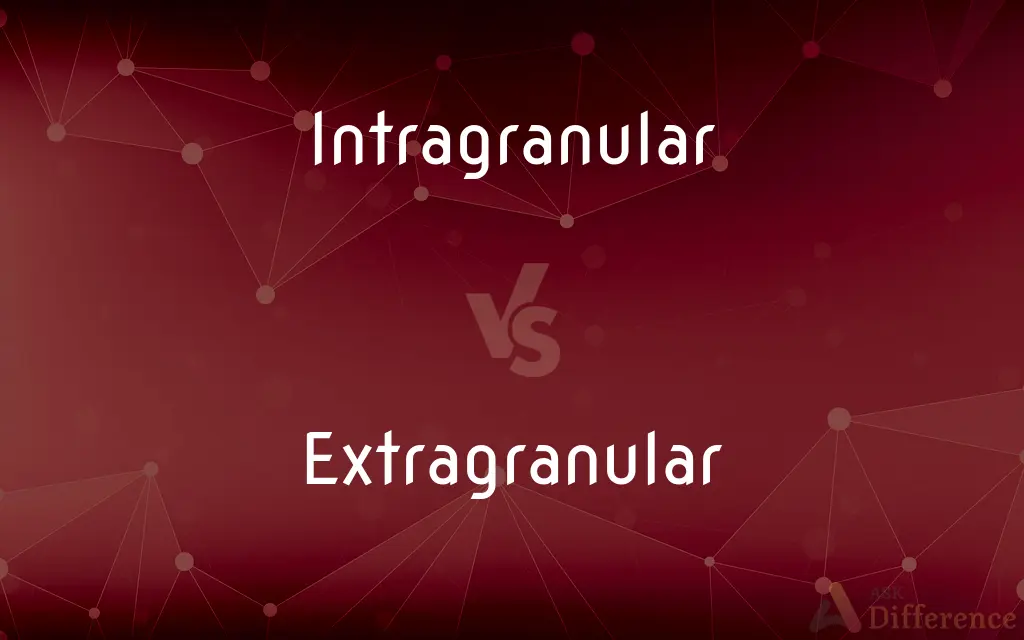Intragranular vs. Extragranular — What's the Difference?
By Tayyaba Rehman & Maham Liaqat — Updated on April 16, 2024
Intragranular refers to processes or features within a grain or crystal, while extragranular involves those external to grains or between them.

Difference Between Intragranular and Extragranular
Table of Contents
ADVERTISEMENT
Key Differences
Intragranular processes occur inside individual grains, affecting their internal structure and composition. On the other hand, extragranular processes impact the spaces between grains, influencing how grains interact and bond with each other.
Intragranular features are crucial in understanding the physical and chemical properties of minerals and materials at a microscopic level. Whereas, extragranular features provide insights into the bulk properties of materials, such as porosity and permeability.
When examining materials under a microscope, intragranular examination focuses on phenomena like crystal defects within a single grain. Conversely, extragranular examination looks at grain boundaries and the interaction between different grains.
In geology, intragranular analysis helps in identifying the history and changes within a rock's crystals. On the other hand, extragranular analysis can explain larger scale geological processes like sedimentation and erosion.
In materials science, engineers study intragranular characteristics to improve the strength and durability of metals and alloys. In contrast, extragranular characteristics are studied to enhance the molding and cohesion of composite materials.
ADVERTISEMENT
Comparison Chart
Location
Within a grain or crystal
Between grains or crystals
Impact on Properties
Affects internal structure and chemical makeup
Influences interactions and bonding between grains
Relevance in Microscopy
Focuses on internal grain defects and phenomena
Examines grain boundaries and intergranular spaces
Importance in Geology
Useful for studying mineral changes within rocks
Crucial for understanding rock formation processes
Application in Materials Science
Enhances properties like strength in metals
Improves molding and cohesion in composites
Compare with Definitions
Intragranular
Relating to phenomena occurring within individual grains of a material.
Intragranular deformation was the focus to understand the alloy's failure under stress.
Extragranular
Pertaining to the area outside or between grains.
Extragranular spaces were filled with resin to enhance the material's structural integrity.
Intragranular
Concerning processes that affect the internal composition of grains.
Intragranular diffusion is studied to improve heat treatment methods.
Extragranular
Relating to phenomena occurring between grains of a material.
Extragranular cementation is crucial in forming solid rock from sediment.
Intragranular
Pertaining to the inside of a grain or crystal.
Intragranular fractures in the crystal were examined to assess its internal stress.
Extragranular
Concerning processes that involve interactions across grain boundaries.
Extragranular bonding was improved to increase the ceramic's resistance to cracking.
Intragranular
Involves microscopic events within the confines of a single grain.
Intragranular oxidation significantly impacts the durability of minerals.
Extragranular
Involves macroscopic events at the boundaries between grains.
Extragranular corrosion can lead to the weakening of metal interfaces.
Intragranular
Internal characteristics of grains analyzed in scientific studies.
Intragranular analysis revealed new insights into the crystal's growth patterns.
Extragranular
External characteristics of grains analyzed in geology and materials science.
Extragranular analysis helps determine the aggregate properties of concrete.
Intragranular
Within a granule
Extragranular
Of or pertaining to additional ingredients added to a material following granulation; outside of a granule.
Extragranular magnesium stearate is added to granule following dry milling
Common Curiosities
What role do intragranular properties play in materials science?
They are essential for understanding and enhancing the internal strength and chemical properties of materials.
How are extragranular characteristics important in constructing materials?
They are critical for improving how materials bond and hold together, impacting overall structural integrity.
What is intragranular?
Intragranular refers to processes or features that occur within individual grains or crystals.
What does extragranular mean?
Extragranular pertains to phenomena or features occurring outside or between grains.
How do intragranular and extragranular features differ in geology?
Intragranular features affect individual mineral grains, while extragranular features influence how these grains aggregate and interact.
Why is extragranular space important in hydrogeology?
It influences water flow and contaminant transport in porous media like soil and rock.
How does intragranular stress differ from extragranular stress?
Intragranular stress occurs within grains under load, whereas extragranular stress occurs between grains.
How does intragranular diffusion affect materials at high temperatures?
It affects how materials behave under thermal stress, impacting their durability and performance.
What does intragranular corrosion mean?
It refers to corrosion that occurs within the grains of a metal, often leading to material degradation.
Can intragranular analysis predict material failure?
Yes, studying intragranular phenomena like stress fractures helps predict and prevent material failures.
What insights do extragranular studies provide in sedimentary geology?
They help in understanding sedimentation processes and the geological history of sedimentary rocks.
What are the environmental impacts of extragranular processes?
They affect soil structure, erosion patterns, and landscape evolution over geological timescales.
What are the applications of extragranular bonding?
It is used to enhance the mechanical properties of composites and ceramics.
What methods are used to study intragranular phenomena?
Techniques like scanning electron microscopy and X-ray diffraction are commonly used.
How do extragranular features affect rock porosity?
They determine the size and connectivity of pore spaces, affecting fluid storage and movement.
Share Your Discovery

Previous Comparison
Electron vs. Photon
Next Comparison
Saw vs. SewAuthor Spotlight
Written by
Tayyaba RehmanTayyaba Rehman is a distinguished writer, currently serving as a primary contributor to askdifference.com. As a researcher in semantics and etymology, Tayyaba's passion for the complexity of languages and their distinctions has found a perfect home on the platform. Tayyaba delves into the intricacies of language, distinguishing between commonly confused words and phrases, thereby providing clarity for readers worldwide.
Co-written by
Maham Liaqat











































